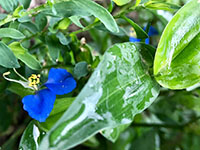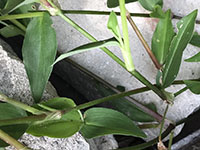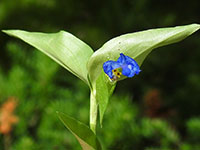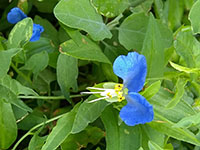![]()
The Asiatic Dayflower is an herbaceous annual plant that belongs to the spiderwort family. Its name is derived from the unique characteristic of its blooms, which last for only a single day before withering away. This delicate yet resilient plant is native to vast regions across East Asia and the northern parts of Southeast Asia. In China, it is referred to as 'yazhicao', a name that translates to "duckfoot herb", while in Japan, it is known as 'tsuyukusa', meaning "dew herb". Though originally confined to these regions, the Asiatic Dayflower has also been introduced to other parts of the world, including central and southeastern Europe and eastern North America. In these new environments, it has proliferated rapidly, often becoming classified as a noxious weed due to its invasive tendencies. The genus name Commelina was chosen in honor of Dutch botanists Johan (1629–1692) and Caspar (1667–1731) Commelin, while the species name 'communis' signifies its widespread presence, meaning "common".
![]()
Throughout history, the Asiatic Dayflower has played a role in traditional Chinese medicine, where it has been used for its various healing properties. In Japan, the plant was highly valued not just for medicinal purposes but also for its contribution to art and culture. The flowers of the plant were utilized in the production of a dye and a pigment that became widely recognized in Ukiyo-e woodcuts, a traditional form of Japanese woodblock printing that flourished during the 18th and early 19th centuries. Additionally, the Asiatic Dayflower has been of scientific interest, particularly in pollination studies, helping researchers understand plant interactions with pollinators and their reproductive behaviors.
![]()
Beyond historical and cultural significance, the Asiatic Dayflower has been widely used in holistic and rational medicine. It has been traditionally prepared as a throat gargle to alleviate sore throats and tonsillitis. The leaves of the plant possess depurative (purifying), diuretic (promoting urine production), and febrifuge (fever-reducing) properties. When dried, the plant can be made into a decoction, a preparation used to treat bleeding, diarrhea, and fever. Scientific research has further suggested that extracts from the plant exhibit antibacterial activity, reinforcing its medicinal potential.
Please note that MIROFOSS does not suggest in any way that plants should be used in place of proper medical and psychological care. This information is provided here as a reference only.
![]()
Aside from its medicinal applications, the Asiatic Dayflower is also edible. The leaves, flowers, and young shoots can be consumed either raw or cooked. The leaves can be finely chopped and added to salads or used as a potherb in various cooked dishes. It is known for having a sweet taste with a mucilaginous (slightly slimy) texture, making it a unique addition to culinary preparations.
Please note that MIROFOSS can not take any responsibility for any adverse effects from the consumption of plant species which are found in the wild. This information is provided here as a reference only.
![]()
In terms of growth and habitat, the Asiatic Dayflower is quite adaptable. It thrives in both partially shaded and sunny areas and can be found in cultivated beds or disturbed ground. The plant is well-suited for light (sandy) and medium (loamy) soils, showing a preference for well-drained soil. It is tolerant of a wide range of pH levels, including acidic, neutral, and alkaline conditions. Additionally, it can grow in both moist and dry soils, making it a versatile species capable of adapting to different environmental conditions.
| Soil Conditions | |
| Soil Moisture | |
| Sunlight | |
| Notes: |
![]()
The Asiatic Dayflower is a creeping perennial plant that typically grows to a length of 20 cm to 75 cm. It spreads along the ground, with its slender stems developing roots whenever they come into contact with the soil, allowing the plant to establish itself easily in different environments. The root system is composed of fibrous roots, which, while effective in anchoring the plant and absorbing nutrients, are susceptible to frost, making the species vulnerable to extreme cold temperatures.
The flowers of the Asiatic Dayflower are bilaterally symmetrical, meaning that they are evenly divided along one plane. They are notable for their vibrant blue coloration and delicate structure, measuring approximately 15 mm in width. Each flower consists of three sepals and one distinctive white petal, adding contrast to its striking appearance. Additionally, each bloom contains six stamens, the pollen-producing structures essential for reproduction. Despite its beauty, the Asiatic Dayflower’s blossoms are short-lived, with each individual flower blooming for just one day before wilting. The plant has an extended flowering season, blooming from June to October in the Northern Hemisphere, ensuring a long period of visual appeal and ecological interaction.
The leaves of the Asiatic Dayflower are lanceolate, meaning they have a long, narrow shape that tapers to a point. Measuring between 8 cm to 13 cm in length, they feature rounded bases that attach smoothly to the stem, giving the plant a lush, elongated appearance. These leaves serve an essential role in photosynthesis and contribute to the plant’s resilience in a variety of environments. The seeds of the Asiatic Dayflower vary in size, typically ranging from 2.5 mm to 4.2 mm in length, though some can be as short as 2 mm. Their width falls between 2.2 mm to 3 mm, and their surface texture is rugose pitted-reticulate, meaning they have a wrinkled, net-like pattern. The seeds are also densely covered with smaller farinose (powdery) granules, with sparser larger granules scattered across the surface. These unique structural characteristics contribute to their dispersal and germination properties, allowing the plant to propagate effectively.
![]()
| Plant Height | 20cm to 75cm | 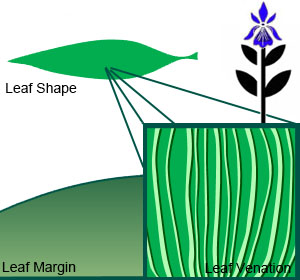 |
| Habitat | Cultivated areas, Disturbed Soil | |
| Leaves | Lanceolate | |
| Leaf Margin | Entire | |
| Leaf Venation | Parallel | |
| Stems | Smooth stems | |
| Flowering Season | June to October | |
| Flower Type | Bilaterally Symmetrical | |
| Flower Colour | Blue | |
| Pollination | Bees | |
| Flower Gender | Flowers are hermaphrodite and the plants are self-fertile | |
| Fruit | Small seeds in a swollen capsule | |
| USDA Zone | 7A (-15°C to -17°C) cold weather limit |
![]()
No known health risks have been associated with Asiatic dayflower. However ingestion of naturally occurring plants without proper identification is not recommended.
![]()
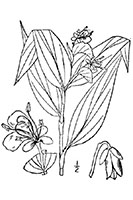 |
-Click here- or on the thumbnail image to see an artist rendering, from The United States Department of Agriculture, of Asiatic dayflower (This image will open in a new browser tab) |
![]()
 |
-Click here- or on the thumbnail image to see a magnified view, from The United States Department of Agriculture, of the seeds created by the Asiatic dayflower for propagation. (This image will open in a new browser tab) |
![]()
Asiatic Dayflower can be referenced in certain current and historical texts under one other name:

![]()
 |
What's this? What can I do with it? |
![]()
| Dickinson, T.; Metsger, D.; Bull, J.; & Dickinson, R. (2004) ROM Field Guide to Wildflowers of Ontario, Royal Ontario Museum, Toronto:McClelland and Stewart Ltd. | |
| Hanelt, Peter; Büttner, R.; Mansfeld, Rudolf; Kilian, Ruth (2001), Mansfeld's Encyclopedia of Agricultural and Horticultural Crops, Springer, p. 2414, ISBN 3-540-41017-1 | |
| Ohwi, Jisaburo (1965), Flora of Japan (in English), Washington, D.C.: Smithsonian Institution, p. 271, ISBN 0-87474-708-2 | |
| Invasive Plants of Asian Origin Established in the United States and Their Natural Enemies, Volume 1, USDA Forest Service, retrieved 2018-12-10 | |
| USDA-NRCS PLANTS Database / USDA NRCS. Wetland flora: Field office illustrated guide to plant species. USDA Natural Resources Conservation Service. | |
| National Audubon Society. Field Guide To Wildflowers (Eastern Region): Alfred A. Knopf. ISBN 0-375-40232-2 | |
| February 22, 2025 | The last time this page was updated |
| ©2025 MIROFOSS™ Foundation | |
 |
|


